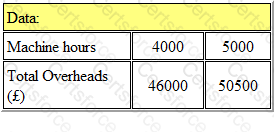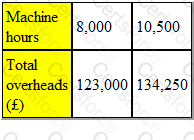Refer to the Exhibit.

PJ Ltd has forecast that the relationship between total overheads and machine hours will be as follows:
If the budget is to be based on 4,000 machine hours, the variable overhead absorption rate will be:
*per machine hour.
Give your answer to 2 decimal places.
Which ONE of the following would be the LEAST effective performance indicator for a distribution manager who is responsible for controlling the cost of the transport fleet?
Refer to the exhibit.

The following data relates to two activity levels of a department. Overhead absorption is on the basis of machine hours.
The variable overhead rate per hour is £4.50. The amount of fixed overhead, to the nearest £000, is:
Refer to the exhibit.

The budget for ORG for the month of September contained the following data:
During the month the actual number of units produced was 1,550. The management accounts showed a direct labour rate variance of $200 adverse and direct labour efficiency variance of $150 adverse.
The actual direct labour hours in the month was:
A budget that is continuously updated by adding a further accounting period when the earliest period has expired is known as:
Refer to the Exhibit.

AM Ltd. makes and sells a single product for which the standard cost information is as follows:
Budgeted production for the period is 30000 units.
The actual results for the period were as follows:

What is the variable overhead expenditure variance?
Within a relevant range of output, the fixed cost per unit of a product will:
Within a relevant range of output, the variable cost per unit of output will:
Refer to the exhibit.

DS is manufacturing company that uses an integrated accounting system. The following payroll data is available for the month of August:
The Employers' National Insurance for the period was $13,790. An analysis of the wages is as follows:
Which of the following factors affect the budgeted cash flow:
(a) Funds from the issue of share capital
(b) Bank Interest on a long term loan
(c) Depreciation on fixed assets
(d) Bad debt write off
The variable overhead efficiency variance is: